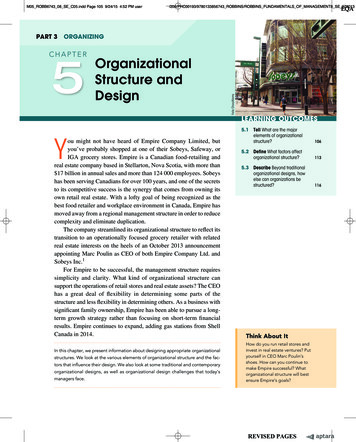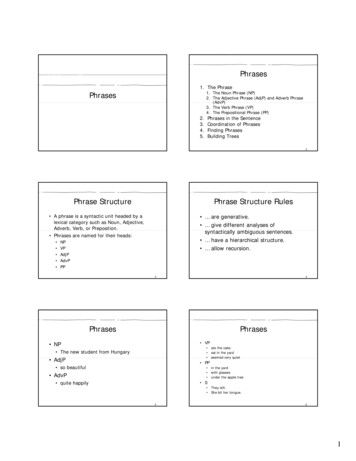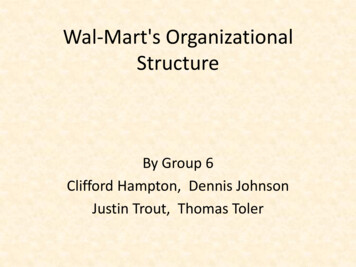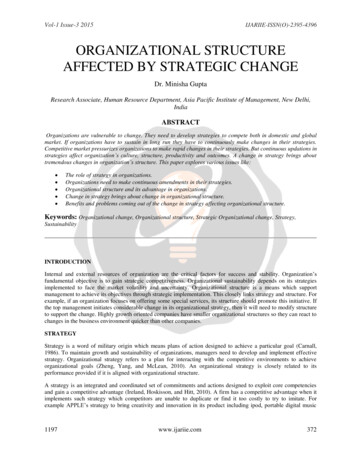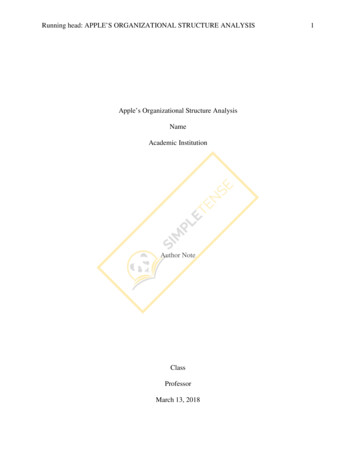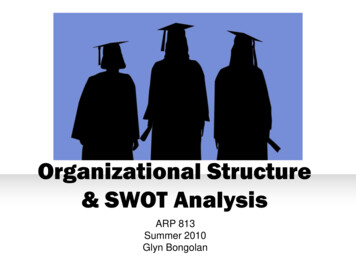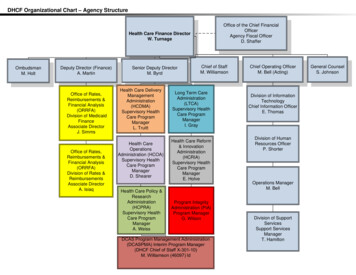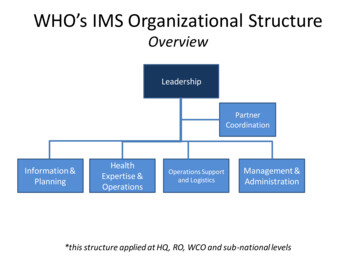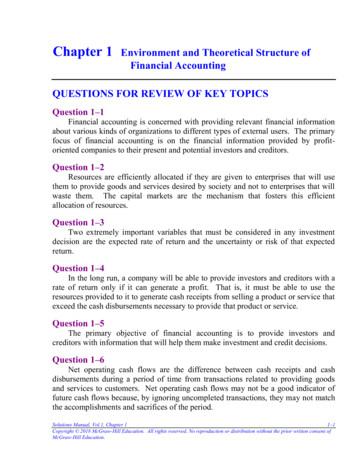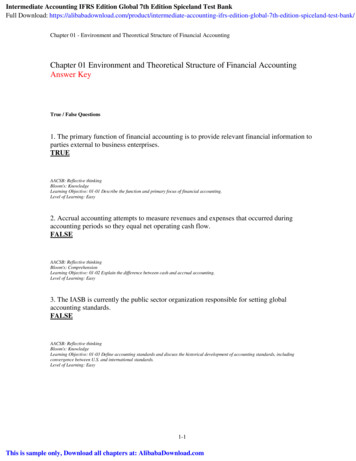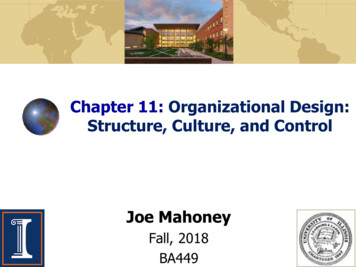
Transcription
Chapter 11: Organizational Design:Structure, Culture, and Control
Chapter Case 11:Zappos: From Happiness to HolacracyCopyright 2017 by McGraw-Hill Education. This is proprietary material solely for authorized instructor use. Not authorized for sale or distributionin any manner. This document may not be copied, scanned, duplicated, forwarded, distributed, or posted on a website, in whole or part.
3Zappos: From Happiness to Holacracy An online shoe and clothing store– The world’s largest shoe store– Also offers handbags, clothing items, eyewear, andaccessories– Mission: deliver happiness Zappo’s has also made investors happy– 10 years after founding, has achieved 1 billion inannual sales– Amazon.com acquired the company for 1.2 billionCopyright 2017 by McGraw-Hill Education. This is proprietary material solely for authorized instructor use. Not authorized for sale or distributionin any manner. This document may not be copied, scanned, duplicated, forwarded, distributed, or posted on a website, in whole or part.
Zappos: From Happiness to Holacracy Zappo’s has experienced rapid growth.– 20 million unique visitors a month It is reorganizing to a “Holacracy”– To offer the best customer service possible– Employees self-direct their work instead of reporting toa manager who tells them what to do. This structure can be difficult to implement.– Zappo’s is the first large corporation to try it.Copyright 2017 by McGraw-Hill Education. This is proprietary material solely for authorized instructor use. Not authorized for sale or distributionin any manner. This document may not be copied, scanned, duplicated, forwarded, distributed, or posted on a website, in whole or part.
Zappos’ Core Values11–5
6Zappos: From Happiness to Holacracy Zappos – online shoe retailer Implementation of holacracy is not going well.– Holacracy distributes power to self-managed teams. Reasons why the implementation was difficult:– Removed paths for clear advancement– The grouping of its over 1,500 employees in some400 circles, with each employee in two or more circles(distributing power and authority) introduced paralysis– Made the organization more political– 200 employees quit.Copyright 2017 by McGraw-Hill Education. This is proprietary material solely for authorized instructor use. Not authorized for sale or distributionin any manner. This document may not be copied, scanned, duplicated, forwarded, distributed, or posted on a website, in whole or part.
Zappos: From Happiness to Holacracy What is a holocracy and how does this organizationalform differ from more traditional structures? Why is Zappos experiencing significantimplementation problems with holacracy? What else could Zappos do toimplement the new organizationalstructure more effectively?Copyright 2017 by McGraw-Hill Education. This is proprietary material solely for authorized instructor use. Not authorized for sale or distributionin any manner. This document may not be copied, scanned, duplicated, forwarded, distributed, or posted on a website, in whole or part.
8Organizational Design and Competitive AdvantageCopyright 2017 by McGraw-Hill Education. This is proprietary material solely for authorized instructor use. Not authorized for sale or distributionin any manner. This document may not be copied, scanned, duplicated, forwarded, distributed, or posted on a website, in whole or part.
11–9
How to Organize for Competitive Advantage Organizational design Structure Processes Procedures Key components: Structure Culture Control Structure follows strategy (or inefficiency results) Consider the inefficiency of Pepsi Restaurants decentralizedstructure, which did not follow their related diversification strategy.
11-10Sources ofBureaucratic CostsNumber ht 1998 by Houghton Mifflin Company. All rights reserved.
13Organizational Inertia A firm’s resistance to change the status quo Can lead to the firm’s subsequent failure The pattern of a firm:––––Mastery of the current environmentSuccess as measured by financial measurementsStructures, measures, and systems to manage sizeOrganizational inertia results from shiftsin the internal and external environment.Copyright 2017 by McGraw-Hill Education. This is proprietary material solely for authorized instructor use. Not authorized for sale or distributionin any manner. This document may not be copied, scanned, duplicated, forwarded, distributed, or posted on a website, in whole or part.
Failure of Firms to Respond to Shifts in the Externalor Internal EnvironmentsExhibit 11.2Copyright 2017 by McGraw-Hill Education. This is proprietary material solely for authorized instructor use. Not authorized for sale or distributionin any manner. This document may not be copied, scanned, duplicated, forwarded, distributed, or posted on a website, in whole or part.
15The Premature Death of a Google-likeSearch Engine at Microsoft Microsoft had a prototype called Keywords.– More than a decade earlier than Google that was shut downbecause managers did not see it as a viable business model. Microsoft almost acquired this capability.– But determined Overture Services was overpriced Launched their own, Bing, in 2009 The CEO has admitted impatience.– Was replaced in 2014 How did problems in Microsoft’s structure and culturecontribute to strategic mistakes concerningtheir search engine decisions?Copyright 2017 by McGraw-Hill Education. This is proprietary material solely for authorized instructor use. Not authorized for sale or distributionin any manner. This document may not be copied, scanned, duplicated, forwarded, distributed, or posted on a website, in whole or part.
The Key Elements of Organizational Structure Organizational structure determines Work efforts of individuals and teams Resource distribution Key building blocks Specialization Formalization Centralization Hierarchy
17Specialization Describes the degree to which a task is divided intoseparate jobs (i.e., the division of labor) Larger firms: high degree of specialization– Ex: Large-firm accountant might do internal auditing Smaller ventures: low degree of specialization– Example: Small-firm accountant might do: Internal auditingPayrollAccounts receivableFinancial planningTaxesCopyright 2017 by McGraw-Hill Education. This is proprietary material solely for authorized instructor use. Not authorized for sale or distributionin any manner. This document may not be copied, scanned, duplicated, forwarded, distributed, or posted on a website, in whole or part.
Formalization Captures the extent to which employee behavior issteered by explicit and codified rules and procedures Is not necessarily negative Often can be necessary for consistent and predictableresults– Example. Pilot training– Example. Customer service call centers Can slow decision making, reduceinnovation, and hinder customer serviceCopyright 2017 by McGraw-Hill Education. This is proprietary material solely for authorized instructor use. Not authorized for sale or distributionin any manner. This document may not be copied, scanned, duplicated, forwarded, distributed, or posted on a website, in whole or part.
19Centralization Refers to the degree to which decision making isconcentrated at the top of the organization Example: BP oil spill in 2010 (Deepwater Horizon)– Decisions made in UK HQ and not on site– Centralization reduced response time and led to aprolonged crisis. Affects strategic planning:– Top-down strategic planning takes place in highlycentralized organizations.– Planned emergence is found in moredecentralized organizations.Copyright 2017 by McGraw-Hill Education. This is proprietary material solely for authorized instructor use. Not authorized for sale or distributionin any manner. This document may not be copied, scanned, duplicated, forwarded, distributed, or posted on a website, in whole or part.
Hierarchy Determines the formal, position-based reporting lines Stipulates who reports to whom Span of control:– The number of employees who directly report to a manager– In tall structures: the span of control is narrow.– In flat structures: the span of control is wide. Meaning one manager supervisesmany employeesCopyright 2017 by McGraw-Hill Education. This is proprietary material solely for authorized instructor use. Not authorized for sale or distributionin any manner. This document may not be copied, scanned, duplicated, forwarded, distributed, or posted on a website, in whole or part.
21Mechanistic vs. Organic Organizations Mechanistic Organization– High degree of specialization and formalization– Tall hierarchies– Rely on centralized decision making e.g., McDonald’s detailed instructions to franchisees Organic Organization– Low degree of specialization and formalization– Flat organizational structure– Decentralized decision making e.g., ZapposCopyright 2017 by McGraw-Hill Education. This is proprietary material solely for authorized instructor use. Not authorized for sale or distributionin any manner. This document may not be copied, scanned, duplicated, forwarded, distributed, or posted on a website, in whole or part.
W. L. Gore & Associates: Informality and Innovation Inventor of path-breaking new products– GORE-TEX fabrics, Glide dental floss,and Elixir guitar strings– Devoted to innovation, imagination and initiative– No formal job titles, job descriptions, chains ofcommand, formal communication channels, written rulesor standard operating procedures Uses a boundryless organization form– Everyone is empoweredCopyright 2017 by McGraw-Hill Education. This is proprietary material solely for authorized instructor use. Not authorized for sale or distributionin any manner. This document may not be copied, scanned, duplicated, forwarded, distributed, or posted on a website, in whole or part.
23W. L. Gore & Associates: Informality and Innovation Organized in project-based teams– Led by sponsors, not bosses– Peer control enhances productivity– Group members evaluate each other’s performance This type of culture has been linked to:– Greater employee satisfaction and retention– Higher personal initiative & creativity– Innovation at the firm levelCopyright 2017 by McGraw-Hill Education. This is proprietary material solely for authorized instructor use. Not authorized for sale or distributionin any manner. This document may not be copied, scanned, duplicated, forwarded, distributed, or posted on a website, in whole or part.
W. L. Gore & Associates: Informality and Innovation What management lessons can be taken fromthe W. L. Gore & Associates (informal)organization structure?Copyright 2017 by McGraw-Hill Education. This is proprietary material solely for authorized instructor use. Not authorized for sale or distributionin any manner. This document may not be copied, scanned, duplicated, forwarded, distributed, or posted on a website, in whole or part.
25Mechanistic vs. Organic OrganizationsExhibit 11.3Mechanistic tionHierarchyOrganic Organizations High degree of specialization Rigid division of labor Employees focus on narrowly defined tasks Low degree of specialization Flexible division of labor Employees focus on “bigger picture” Intimate familiarity with rules, policies, andprocesses necessary Deep expertise in narrowly defined domainrequired Task-specific knowledge valued Clear understanding of organization’s corecompetencies and strategic intent Domain expertise in different areas Generalized knowledge of how to accomplishstrategic goals valued Decision power centralized at top Vertical (top-down) communication Distributed decision making Vertical (top-down and bottom-up) as well ashorizontal communication Flat structures High span of control Horizontal as well as two-way verticalcommunication Mutual adjustmentTall structuresLow span of controlClear lines of authorityCommand and control Cost-leadership strategy Differentiation strategyBusinessStrategyCopyright 2017 by McGraw-Hill Education.This is proprietarymaterial solely for authorizedinstructor use. Not authorized for saleor distribution W.L. Gore, Zappos Examples:McDonald’s;WalmartExamples:in any manner. This document may not be copied, scanned, duplicated, forwarded, distributed, or posted on a website, in whole or part.
Strategy and StructureCopyright 2017 by McGraw-Hill Education. This is proprietary material solely for authorized instructor use. Not authorized for sale or distributionin any manner. This document may not be copied, scanned, duplicated, forwarded, distributed, or posted on a website, in whole or part.
27Firm Strategy and Structure Are interdependent Impact a firm’s performance Changes over time as the firm grow in:– Size and complexity Successful new ventures generally grow:– First by increasing sales– Then by obtaining larger geographic reach– Finally by diversifying Through vertical integration Entering into related and unrelated businessesCopyright 2017 by McGraw-Hill Education. This is proprietary material solely for authorized instructor use. Not authorized for sale or distributionin any manner. This document may not be copied, scanned, duplicated, forwarded, distributed, or posted on a website, in whole or part.
Types of Organizational StructureExhibit 11.4 Simple Functional Multidivisional MatrixCopyright 2017 by McGraw-Hill Education. This is proprietary material solely for authorized instructor use. Not authorized for sale or distributionin any manner. This document may not be copied, scanned, duplicated, forwarded, distributed, or posted on a website, in whole or part.
29Simple Structure Generally used by small firms with low organizationalcomplexity Founders
competencies and strategic intent Domain expertise in different areas Generalized knowledge of how to accomplish strategic goals valued Centralization Decision power centralized at top Vertical (top-down) communication Distributed decision making Vertical (top-down and bottom-up) as well as horizontal communication Hierarchy
